Science
Researchers Boost Quantum Computing Reliability with Error Correction

Recent research has made significant strides in enhancing the reliability of quantum computers through advanced error correction techniques. Scientists have focused on quantum error correction codes, which protect quantum information from issues like decoherence and quantum noise. These codes are vital for developing more complex and dependable quantum algorithms.
One notable example is the five-qubit error correction code. This code requires a minimum of five physical qubits—units of quantum information that can be created using technologies such as trapped ions or superconducting circuits—to correct errors in a single logical qubit. Despite these advancements, imperfections in hardware can still lead to quantum errors, prompting researchers to seek more robust solutions.
Advancements in Self-Testing Techniques
A key method for testing quantum error correction codes is known as self-testing. This technique allows researchers to verify quantum properties using only input-output statistics, treating quantum devices as black boxes. The approach has evolved from examining bipartite systems, which consist of two quantum subsystems, to exploring multipartite entanglement involving three or more subsystems. The latest developments focus on genuinely entangled subspaces, where every state is fully entangled across all subsystems.
Genuinely entangled subspaces provide stronger and more reliable entanglement than general multipartite states, making them essential for quantum computing and effective error correction. In the current research, self-testing methods were applied to certify these genuinely entangled logical subspaces within the five-qubit code on both photonic and superconducting platforms.
The researchers prepared informationally complete logical states spanning the entire logical space. This configuration is crucial as it fully characterizes the system’s behavior. To simulate real-world conditions, the team deliberately introduced basic quantum errors by mimicking Pauli errors on the physical qubits, creating noise similar to what might be encountered in practical applications.
Results and Implications
To evaluate the system’s performance after introducing errors, the researchers employed mathematical tests known as Bell inequalities, tailored for the framework of quantum error correction. These tests assess whether the system remains within the initial logical subspaces post-error introduction.
The results, measured by extractability scores, indicate how closely the tested quantum system aligns with the ideal target state, where a score of 1 signifies a perfect match. The certification process yielded extractability measures of 0.828 ± 0.006 for the photonic system and 0.621 ± 0.007 for the superconducting system. The photonic platform achieved a high score, demonstrating that its logical subspace closely approximates the ideal state, while the superconducting platform, despite a lower score, still exhibited meaningful entanglement.
These findings confirm that the self-testing method is effective in practice and validates strong entanglement within the five-qubit code across both platforms.
This research not only advances quantum technologies but also establishes robust methods for verifying and characterizing complex quantum structures. Such developments are crucial for creating reliable and scalable quantum systems. Furthermore, the study illustrates that device-independent certification can extend beyond quantum states and measurements, encompassing more generalized quantum structures.
For more detailed insights, the complete study can be found in the article titled “Certification of genuinely entangled subspaces of the five-qubit code via robust self-testing” by Yu Guo et al., published in 2025 Report on Progress in Physics.
-

 Health3 months ago
Health3 months agoNeurologist Warns Excessive Use of Supplements Can Harm Brain
-

 Health3 months ago
Health3 months agoFiona Phillips’ Husband Shares Heartfelt Update on Her Alzheimer’s Journey
-

 Science2 months ago
Science2 months agoBrian Cox Addresses Claims of Alien Probe in 3I/ATLAS Discovery
-

 Science2 months ago
Science2 months agoNASA Investigates Unusual Comet 3I/ATLAS; New Findings Emerge
-

 Science1 month ago
Science1 month agoScientists Examine 3I/ATLAS: Alien Artifact or Cosmic Oddity?
-

 Entertainment5 months ago
Entertainment5 months agoKerry Katona Discusses Future Baby Plans and Brian McFadden’s Wedding
-

 Science1 month ago
Science1 month agoNASA Investigates Speedy Object 3I/ATLAS, Sparking Speculation
-

 Entertainment4 months ago
Entertainment4 months agoEmmerdale Faces Tension as Dylan and April’s Lives Hang in the Balance
-

 World3 months ago
World3 months agoCole Palmer’s Cryptic Message to Kobbie Mainoo Following Loan Talks
-

 Science1 month ago
Science1 month agoNASA Scientists Explore Origins of 3I/ATLAS, a Fast-Moving Visitor
-

 Entertainment2 months ago
Entertainment2 months agoLewis Cope Addresses Accusations of Dance Training Advantage
-

 Entertainment3 months ago
Entertainment3 months agoMajor Cast Changes at Coronation Street: Exits and Returns in 2025









